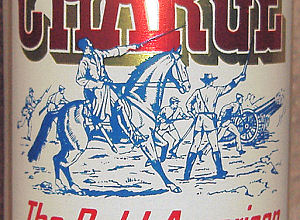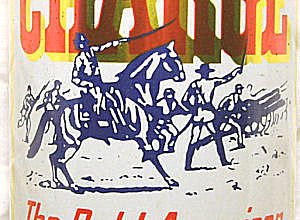|
BREWERIANA ROOM 1 - Cans, Bottles, Caps, & Openers "Breweriana" is commonly defined as "collectible historical Brewery advertising". Examples include beer cans, bottles, openers, tin signs, coasters, beer trays, wooden cases and neon signs. The term "breweriana" first appeared in the National lexicon with the 1972 formulation of the National Association of Breweriana Advertising, also known as NABA. Please note: Photos from outside sources may enlarge only a little or not at all.
Click Photos to Enlarge Cans & Openers Bottles & Caps Charge Beer - A Tale of Two Labels The exact issue dates for the two different Charge Premium beer can labels are unclear at this time, however, work to uncover the truth continues. We have identified them as Version 1 (graphically superior details) and Version 2 (fewer details).  Version 1 Version 1The most obvious difference between the two labels is the graphics, with Version 1 being far cleaner and superior to Version 2. Other differences are minor but noteworthy. On Version 1, the soldier on the horse is holding a straight sword. On Version 2, he holds a curved sword. Also, the letters in the word "Charge" are enhanced with white outlines on Version 1. The first cans for the brewery were West Virginia Special cone-tops (ie: spout-top or cap-sealed cans), produced for Fesenmeier in the 1950s by the Crown Cork & Seal Company. For the rest of its history, all cans for the brewery appear to have been made by Heekin Can Company of Cincinnati except Charge Version 2, made by Continental Can Company. The top lids used on Version 1 were American Can Company's original 1966 design, including a smattering of gold lids. On eBay I had seen a lot of Charge cans with gold lids and finally decided to get one for my collection. Oddly, the tab is gold but the pull-ring is silver. The top lids used on Version 2 were Continental's 1967 design, minus the "Lift Ring and Pull" instructions, which would seem to suggest that Version 2 came later. Cans arrived at Little Switzerland from Heekin without bottom lids, as the brewery filled its cans upside down. A number of good theories exist as to what advantage this gave them, but so far there is nothing conclusive. Nevertheless, between the years of the brewery's demolition and the dawn of eBay, the most common Charge cans to be found were Version 1 with no bottom lids. They are still easily acquired to this day. I don't recall having ever seen a single bottomless Version 2. So which one is more prevalent? That's easy. A simple search on eBay will show there are far more Version 1 cans floating around than Version 2, with the overwhelming majority being "air-filled" promotional cans. More than thirty of these reside in my collection.  Version 2 Version 2I found my first Charge can in the woods when I was a kid. I believe it may have been Version 2, because I distinctly remember not being knocked out by the graphics. I wish I still had that can. It might help answer some questions. I currently have four Version 2 cans and only one of these is "air-filled." Two have the Little Switzerland tax stamp on the bottom. In the past, a few Huntington collectors reported having examples of both Charge and West Virginia Pilsner cans with a Fesenmeier tax stamp on them. Knowing which version of Charge cans these lids were placed on would help determine which one actually came first. It is easy to imagine that the Version 1 cans were too costly to produce due to their superior graphics and were phased out at some point. The early lid design would seem to bare this out. Our guess is that Version 1 cans were initially given out as promotional items when the brand was introduced in 1968. The exact dates involved and the number filled with beer and sent to market remain unknown. In any case, thousands of beer cans were rescued from Little Switzerland before developers tore the brewery down to make way for the wonderful folks at Kroger, so they could build a new store and then abandon it within a couple of years. |


























